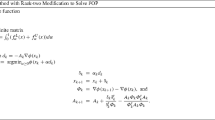Abstract
The present paper is a humble attempt to develop a fuzzy function approximator which can completely self-generate its fuzzy rule base and input-output membership functions from an input-output data set. The fuzzy system can be further adapted to modify its rule base and output membership functions to provide satisfactory performance. This proposed scheme, called generalised influential rule search scheme, has been successfully implemented to develop pure fuzzy function approximators as well as fuzzy logic controllers. The satisfactory performance of the proposed scheme is amply demonstrated by implementing it to develop different major components in a process control loop. The versatility of the algorithm is further proved by implementing it for a benchmark nonlinear function approximation problem.
Similar content being viewed by others
References
Jang JSR, Sun CT (1995) Neuro-fuzzy modeling and control. IEEE Proc 83(3):378–405
Rojas I, Pomares R, Ortega J, Prieto A (2000) Self-organised fuzzy system generation from training examples. IEEE Trans Fuzzy Syst 8(1):23–36
Guillaume S (2001) Designing fuzzy inference systems from data: an interpretability-oriented review. IEEE Trans Fuzzy Syst 9(3):426–443
Wang LX, Mendel JM (1992) Generating fuzzy rules by learning from examples. IEEE Trans Syst Man Cyber 22(6):1414–1427
Ishibuchi H, Nozaki K, Tanaka H, Hosuka Y, Matsuda M (1994) Empirical study on learning in fuzzy systems by rice test analysis. Fuzzy Sets Syst 64:129–144
Nozaki K, Ishibuchi H, Tanaka H (1997) A simple but powerful heuristic method for generating fuzzy rules from numerical data. Fuzzy Sets Syst 86:251–270
Hong TP, Lee CY (1996) Induction of fuzzy rules and membership functions from training examples. Fuzzy Sets Syst 84:33–47
Hong TP, Chen JB (1999) Finding relevant attributes and membership functions. Fuzzy Sets Syst 103:389–404
Hong TP, Chen JB (2000) Processing individual fuzzy attributes for fuzzy rule induction. Fuzzy Sets Syst 112:127–140
Zapata GOA, Galvao RKH, Yoneyama T (1999) Extracting fuzzy control rules from experimental human operator data. IEEE Trans Syst Man Cybern B Cybern 29(3):398–406
Wu TP, Chen SM (1999) A new method for constructing membership functions and fuzzy rules from training examples. IEEE Trans Syst Man Cybern B Cybernet 29(1):25–40
Klawonn F, Kruse R (1997) Constructing a fuzzy controller from data. Fuzzy Sets Syst 85(2):177–193
Langari R, Wang L (1996) Fuzzy models, modular networks and hybrid learning. Fuzzy Sets Syst 79(2):141–150
Rovatti R, Guerrieri R (1996) Fuzzy sets of rules for system identification. IEEE Trans Fuzzy Syst 4(1):89–102
Pomares H, Rojas I, Ortega J, Gonzalez J, Prieto A (2000) A systematic approach to a self-generating fuzzy rule-table for function approximation. IEEE Trans Syst Man Cybernet B Cybernet 30(3):431–447
Zeng X-J, Singh MG (1996) Approximation accuracy analysis of fuzzy systems as function approximators. IEEE Trans Fuzzy Syst 4(1):44–63
Lin CT, Lee CSG (1991) Neural-network-based fuzzy logic control and decision system. IEEE Trans Comput 40(12):1320–1336
Jang JSR (1993) ANFIS: Adaptive-network-based fuzzy inference system. IEEE Trans Syst Man Cybernet 23(3):665–685
Simpson PK (1992) Fuzzy min-max neural networks – Part 1: Classification. IEEE Trans Neural Netw 3(5):776–786
Abe S, Lan MS (1995) Fuzzy rules extraction directly from numerical data for function approximation. IEEE Trans Syst Man Cybernet 25(1):119–129
Thawonmas R, Abe S (1999) Function approximation based on fuzzy rules extracted from partitioned numerical data. IEEE Trans Syst Man Cybern B Cybernet 29(4):525–534
Keller J, Yager R, Tahani H (1992) Neural network implementation of fuzzy logic. Fuzzy Sets Syst 45:1–12
Nauck D, Kruse R (1999) Neuro-fuzzy systems for function approximation. Fuzzy Sets Syst 101:261–271
Cho KB, Wang BH (1996) Radial basis function based adaptive fuzzy systems and their applications to system identification and prediction. Fuzzy Sets Syst 83:325–339
Lotfi A, Tsoi AC (1996) Learning fuzzy inference systems using an adaptive membership function scheme. IEEE Trans Syst Man Cybern B Cybernet 26(2):326–331
Wang C-C, Her S-M (1999) A self-generating method for fuzzy systems design. Fuzzy Sets Syst 103:13–25
Guély F, La R, Siarry P (1999) Fuzzy rule base learning through simulated annealing. Fuzzy Sets Syst 105:353–363
Guély F, Siarry P (1994) A centered formulation of Takagi-Sugeno rules for improved efficiency. Fuzzy Sets Syst 62:277–285
Siarry P, Guély F (1998) A genetic algorithm for optimizing Takagi-Sugeno fuzzy rule bases. Fuzzy Sets Syst 99:37–47
Russo M (1998) FuGeNeSys–-a fuzzy genetic neural system for fuzzy modeling. IEEE Trans Fuzzy Syst 6:373–388
Chatterjee A, Rakshit A (2004) Influential rule search scheme (IRSS) – a new fuzzy pattern classifier. IEEE Trans Knowledge Data Eng 16(8):881–893
Chatterjee A, Rakshit A, Siarry P (2005) A new adaptive fuzzy controller with saturation employing influential rule search scheme (IRSS) (submitted)
Mudi RK, Pal NR (1999) A robust self-tuning scheme for PI- and PD-type fuzzy controllers. IEEE Trans Fuzzy Syst 7(1):2–16
Demuth H, Beale M (1998) Neural network toolbox for use with MATLAB user's guide, Version 3.0. The MathWorks Inc.
Sugeno M, Yasukawa T (1993) A fuzzy logic based approach to qualitative modeling. IEEE Trans Fuzzy Syst 1(1):7–31
Nozaki K, Ishibuchi H, Tanaka H (1997) A simple but powerful method for generating fuzzy rules from numerical data. Fuzzy Sets Syst 86:251–270
Kim E, Lee H, Park M, Park M (1998) A simply identified Sugeno-type fuzzy model via double clustering. Inform Sci 110:25–39
Kim E, Park M, Seunghwan J, Ji S, Park M (1997) A new approach to fuzzy modeling. IEEE Trans Fuzzy Syst 5(3):328–337
Tsekouras G, Sarimveis H, Kavakli E, Bafas G (2005) A hierarchical fuzzy clustering approach to fuzzy modeling. Fuzzy Sets Syst 150:245–266
Author information
Authors and Affiliations
Rights and permissions
About this article
Cite this article
Chatterjee, A., Rakshit, A. & Siarry, P. Generalised influential rule search scheme for fuzzy function approximation. Soft Comput 10, 631–642 (2006). https://doi.org/10.1007/s00500-005-0471-2
Published:
Issue Date:
DOI: https://doi.org/10.1007/s00500-005-0471-2




